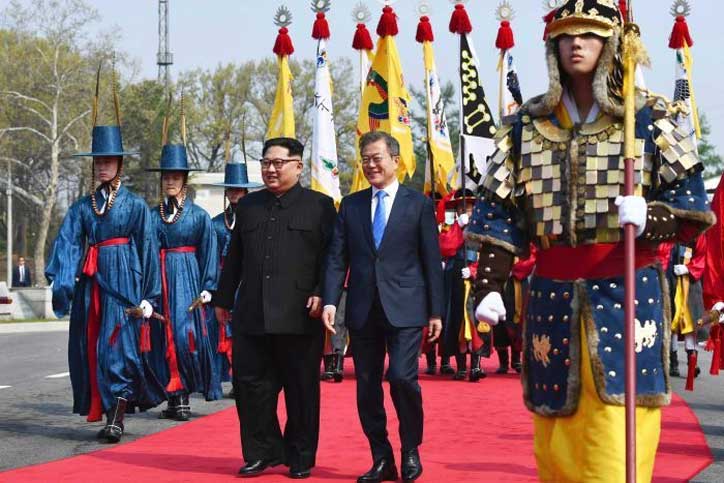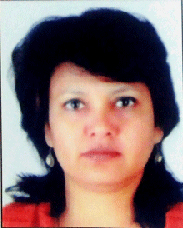 Seoul:
Seoul: The golden doors on the stately North Korean building swung open and leader Kim Jong Un, in a black Mao suit and surrounded by a gaggle of officials, descended the steps toward the border.
Not since the 1950-53 Korean War had a North Korean leader set foot on South Korean soil.
With a smile, Kim stretched out his hand toward a waiting, and smiling, South Korean President Moon Jae-in, who stood between the squat, light blue buildings that straddle the border at Panmunjom.
The village is one of the few places where there are no high barbed wire fences or minefields between the two countries, separated by a conflict that ended with a truce, not a treaty, meaning they are still technically at war.
"I was excited to meet at this historic place and it is really moving that you came all the way to the demarcation line to greet me in person," Kim said as he grasped Moon's hand across the border.
"It was your big decision to make it here," said Moon, dressed in a dark suit and light blue tie, who invited Kim to step over the line in the pavement, which he did.
A prospect that seemed unthinkable just a few months ago has become a reality. At a historic summit, North Korean leader Kim Jong-un, clad in his trademark black Mao suit, met South Korean President Moon Jae-in at the world's most heavily armed border on Friday morning. The two leaders spontaneously shook hands and posed for the photographs at the Demarcation Line Zone dividing the North from the South. Both Kim and Moon headed to the Panmunjom's Peace House, where the official historic summit will take place.
"I am happy to meet you," Moon Jae-in told Kim Jong-un, ABC report said.
Kim Jong-un has become the first North Korean leader to cross over to the southern side of the Demilitarised Zone since the Korean War ended in 1953. Kim Jong-un and Moon Jae-in have decided to hold talks over the subjects of worldwide implications -- the denuclearisation of the Korean Peninsula, a formal peace agreement and the improvement of bilateral relations. The outcomes of this meeting will likely help determine the possible future meeting with Donald Trump and Kim. The North's nuclear arsenal will be high on the agenda at the highly anticipated summit talks.
The summit meeting, aimed at ending their decades-long conflict and easing tensions over the North’s nuclear weapons programme, comes weeks before Kim Jong-un is due to meet US President Donald Trump by early June. The new round of nuclear negotiations between Pyongyang and Seoul is taking place after North Korea suspended further tests of atomic weapons and intercontinental ballistic long-range missiles. Also, according to geologists, the mountain above North Korea's major nuclear test site has collapsed, making it unsafe for further testing, and will be monitored for any radiation leakage. The White House said it was hopeful that the talks between the two Korean leaders would make progress towards peace and prosperity.
The world has isolated North Korea and China has also cut off almost all meaningful trade across the border with the rogue regime.
Here are the top developments on the historic summit meeting between North Korean leader Kim Jong-un and South Korean President Moon Jae-in:
1. Kim Jong-un and Moon Jae-in come face-to-face: The scenes that unfolded at the Panmunjom truce village on Friday were unimaginable a few months earlier. South Korean President Moon Jae-in greeted North Korean leader Kim Jong-un at the military demarcation line at 9:30 am local time (0030 GMT), making Kim the first North Korean leader to set foot in South Korea since the 1950-53 Korean War. “I had so many mixed feelings as I was crossing the demarcation line,” Kim spoke before live television cameras, reported The Age.
Kim was accompanied by nine officials, including his sister Kim Yo-jong, who had led the North's delegations to the Winter Olympic Games in South Korea earlier this year, ABC news reported. The South Korean leader's delegation included ministers for foreign affairs, defence and confederation. The two heads of the Korean states walked on a red carpet and were escorted by a South Korean honour guard in historical costumes and traditional music playing in the background. The two leaders have headed to the Peace House for a private discussion.
The duo will attend an elaborate dinner, to be held around 6.30 pm local time, that will include symbolic dishes originating from both the Korean nations. The Peace House where the historic inter-Korean Summit will take place is situated in Panmunjom, the truce village on the north-south border of the peninsula.
2. The focus of the leadership summit talks: The leadership meeting is likely to facilitate negotiations over Kim Jong-un’s commitment of denuclearisation of nuclear weapons programme. The summit is the result of months of diplomatic negotiations and discussions to make North Korea freeze and denuclearise its nuclear arsenals permanently.
Last year Pyongyang carried out its sixth nuclear blast, by far its most powerful to date, and launched missiles capable of reaching the US mainland. Its actions sent tensions soaring as Kim and Trump traded personal insults and threats of war. Moon Jae-in had seized on the South's Winter Olympics as an opportunity to broker dialogue with North Korea and had observed that his meeting with Kim will serve to set up the summit between Pyongyang and Washington. The summit is expected to set the stage for the first meeting between sitting US president Donald Trump and North Korean leader Kim Jong Un in May or June. Getting the symbolism right, will be a top priority for Moon, who hopes to avoid the failures of past efforts to secure peace. At the end of the talks, Kim and Moon are expected to sign a pact and make a joint statement.
3. Will North Korea denuclearise its nuclear arsenal?: If North Korea fulfils its commitment to completely dismantle the development of nuclear weapons and missiles, initiated by his grandfather, it would mean a significant reversal for the young Korean leader who has staked his security on his nuclear arsenal and spent years celebrating such weapons as an integral part of his regime’s legitimacy and power. South Korea said the rogue regime’s decision signified "meaningful" progress toward denuclearisation of the Korean peninsula and would create favourable conditions for successful talks. Kim’s dramatic announcement did not include a commitment to freeze its existing nuclear weapons and missiles that have raised doubts if he would ever give up the nuclear arsenal his nation has been developing for decades. According to a report in Reuters, experts say that North Korea’s offer not to test or transfer nuclear weapons appeared as a statement of an aim to be a “responsible” nuclear weapons state, rather than an intention to denuclearise. North Korea argued the weapons are vital for its self-defense, but it has decided to give them up in exchange for an end to US "hostile policy”, reported BBC news.
4. North Korea's nuclear test site collapses: Research by Chinese geologists shows the mountain above North Korea's main nuclear test site has collapsed, rendering it unsafe for further testing and requiring that it be monitored for any leaking radiation, reported AP. This may shed new light on North Korean President Kim Jong Un's announcement that his country was ceasing its nuclear testing programme. Nuclear explosions release enormous amounts of heat and energy, and the North's largest test in September was believed early on to have rendered the site in northeastern North Korea unstable. Chinese authorities have said they have detected no radiation risk from samples collected along the border.
5. Donald Trump hails North Korea’s commitment for denuclearisation: After the announcement about the suspension of the nuclear testing by the North Korea, US President Donald Trump tweeted, "This is very good news for North Korea and the World" and "big progress!" He also said he's looking forward to his upcoming summit with Kim.
 Seoul: The golden doors on the stately North Korean building swung open and leader Kim Jong Un, in a black Mao suit and surrounded by a gaggle of officials, descended the steps toward the border.
Seoul: The golden doors on the stately North Korean building swung open and leader Kim Jong Un, in a black Mao suit and surrounded by a gaggle of officials, descended the steps toward the border.